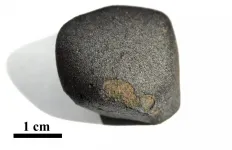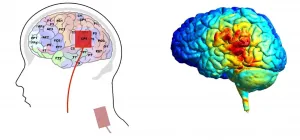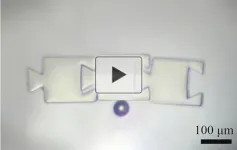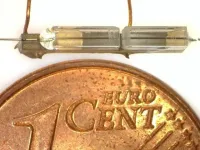(Press-News.org) University of Arizona researchers read between the lines of tree rings to reconstruct exactly what happened in Alaska the year that the Laki Volcano erupted half a world away in Iceland. What they learned can help fine-tune future climate predictions.
In June 1783, Laki spewed more sulfur into the atmosphere than any other Northern Hemisphere eruption in the last 1,000 years. The Inuit in North America tell stories about the year that summer never arrived. Benjamin Franklin, who was in France at the time, noted the "fog" that descended over much of Europe in the aftermath, and correctly reasoned that it led to an unusually cold winter on the continent.
Previous analyses of annual tree rings have shown that the entire 1783 growing season for the spruce trees in Alaska was colder than average. But Julie Edwards, a first-year doctoral student in the School of Geography, Development and Environment reasoned that since Laki erupted in June, it doesn't make sense to assume that the entire growing season, which starts in May for the trees they analyzed, was cooler than normal. So, she set out to solve the mystery.
Edwards is lead author of a new paper published in the Journal of Geophysical Research that outlines how she and her collaborators, using an alternative method called quantitative wood analysis, painted a different picture of Alaskan climate that year.
What happens to the climate a half a world away from the eruption reflects a combination of forces - what the volcano did and the natural variability in the climate. To really understand how volcanoes affect the climate system, the UArizona team looked closely at the structure of tree rings to reveal what happened to the climate on a finer time scale.
Edwards cut a very thin slice of tree ring and dyed it. Using computer software, she calculated the thickness of each of the stained cells. In warm years, the walls of these cells are thickened, and the wood appears darker. In cold years, however, the cell walls are thin, and the wood appears light and less dense.
"This is quantitative wood anatomy, and what we're doing is looking at cellular scale measurements on a cell-by-cell basis to see how climate is imprinting on cell growth throughout a season," Edwards said. "Using this technique, we can measure growth week by week."
With this new way of seeing climate history, the researchers found that Alaskan trees in 1783 started off growing like they would in any normal year. A few months after Laki erupted, the trees suddenly stopped growing much earlier than in normal years, and only a very thin wall was formed in the last part of the ring.
"This suggests a sudden cooling at the end of the growing season, which is a different result than what you'd get by just looking at annual tree-ring width or wood density," said paper co-author Kevin Anchukaitis, an associate professor in the School of Geography, Development, and Environment and the Laboratory of Tree Ring Research. "What Julie's work shows is that using this fine-scale analysis, this week-to-week perspective from individual cells, it is possible to explain the previous and unexpected observation that the entire summer of 1783 was cold in Alaska and get a much better perspective on a truly extreme climate event."
Edwards is one of only a few scientists in the United States to use the quantitative wood anatomy technique. The method has been previously used mostly in Europe, where she participated in a weeklong workshop in San Vito di Cadore, a small town in the Italian Alps, to learn the method from the people who perfected it.
Edwards said it was also important for her and her collaborators to factor in natural variability in climate to check their result.
Partnering with climate modeler Brian Zambri from the Massachusetts Institute of Technology, the team used a computer model to see how natural year-to-year variations in climate could have changed tree growth.
"The model was run a total of 80 times," Anchukaitis said. "The first 40 times, we allowed the eruption to occur. Then, the model was run another 40 times without the eruption, and we compared the results."
The researchers saw a wide range of climate conditions following the eruptions. Some years were especially cold immediately following the eruption, but some were warm. Natural variability in the climate seems to overwhelm any cooling from the volcano.
"Many of the model runs agree with what the trees tell us," Anchukaitis said. "Summer starts normally and then a few months after the eruption, things rapidly get cold. This serves as independent evidence of what we interpret from the trees in 1783."
The study demonstrates that the traditional way of studying tree rings doesn't always provide enough detail when studying rapid or extreme climate events, and also that natural variability in the system can be more important than once thought.
"We use these proxy measurements of past climate, including tree rings, as one way to validate our climate models," Edwards said. "We want to be able to look at these extreme scenarios and have our climate models accurately simulate them and understand the role of natural variability."
INFORMATION:
A meteorite that fell in northern Germany in 2019 contains carbonates which are among the oldest in the solar system; it also evidences the earliest presence of liquid water on a minor planet. The high-resolution Ion Probe - a research instrument at the Institute of Earth Sciences at Heidelberg University - provided the measurements. The investigation by the Cosmochemistry Research Group led by Prof. Dr Mario Trieloff was part of a consortium study coordinated by the University of Münster with participating scientists from Europe, Australia and the USA.
Carbonates are ubiquitous rocks on Earth. They can be found in the mountain ranges of the Dolomites, the chalk cliffs on the island of Rügen, and in the coral reefs of the ...
Transcranial direct current stimulation (tDCS) is a non-invasive method of brain stimulation, in which electrodes are applied over certain places on the scalp, creating a weak electric field. It is currently used for a variety of purposes: from treating depression and pain syndromes to better acquisition of new words and even sports techniques.
During stimulation, the active electrode can transmit a positive or negative electrical charge. In the former case, this stimulation is called 'anodal'; in the latter one, it is called 'cathodal'. Researchers believe that anodal tDCS generally leads to depolarisation of neurons, which increases the likelihood of their excitation when new information arrives. Cathodal ...
As the United States struggles to control record-breaking increases in COVID-19 infections and hospitalizations, the roll-out of two approved vaccines offers tremendous hope for saving lives and curbing the pandemic. To achieve success, however, experts estimate that at least 70 to 90 percent of the population must be inoculated to achieve herd immunity, but how can we ensure folks will voluntarily receive a vaccine?
Both vaccines require two injections. Pfizer-BioNTech's second dose must be given 21 days after the first and Moderna's second dose must be administered 28 days after the first. While public health and infectious disease experts have discussed strategies to enhance adherence, including the potential use of financial incentives, ...
One more piece of the puzzle has fallen into place behind a new drug whose anti-cancer potential was developed at the University of Alberta and is set to begin human trials this year, thanks to newly published research.
"The results provide more justification and rationale for starting the clinical trial in May," said first author John Mackey, professor and director of oncology clinical trials in the Faculty of Medicine & Dentistry. "It's another exciting stepping stone to finding out if this is going to be a new cancer treatment."
The drug PCLX-001 is designed to selectively kill cancer cells by targeting enzymes ...
Better grades thanks to your fellow students? A study conducted by the University of Zurich's Faculty of Business, Economics and Informatics has revealed that not only the grade point average, gender and nationality peers can influence your own academic achievement, but so can their personalities. Intensive contact and interaction with persistent fellow students improve your own performance, and this effect even endures in subsequent semesters.
Personality traits influence many significant outcomes in life, such as one's educational attainment, income, career achievements or health. Assistant Professor Ulf Zölitz of the University of Zurich's Department of Economics and Jacobs Center for Productive Youth Development has investigated how one's own personality affects fellow students.
The ...
Robots are widely used to build cars, paint airplanes and sew clothing in factories, but the assembly of microscopic components, such as those for biomedical applications, has not yet been automated. Lasers could be the solution. Now, researchers reporting in ACS Applied Materials & Interfaces have used lasers to create miniature robots from bubbles that lift, drop and manipulate small pieces into interconnected structures. Watch a video of the bubble microrobots in action here.
As manufacturing has miniaturized, objects are now being constructed that are only a few hundred micrometers long, or about the thickness of a sheet of paper. But it is hard to position ...
HOUSTON - (Jan. 20, 2021) - Once upon a time, seasons in Gale Crater probably felt something like those in Iceland. But nobody was there to bundle up more than 3 billion years ago.
The ancient Martian crater is the focus of a study by Rice University scientists comparing data from the Curiosity rover to places on Earth where similar geologic formations have experienced weathering in different climates.
Iceland's basaltic terrain and cool weather, with temperatures typically less than 38 degrees Fahrenheit, turned out to be the closest analog to ancient Mars. The study determined that temperature had the biggest impact on how rocks formed from sediment ...
Since SARS-CoV-2 was identified in December 2019, researchers have worked feverishly to study the novel coronavirus. Although much knowledge has been gained, scientists still have a lot to learn about how SARS-CoV-2 interacts with the human body, and how the immune system fights it. Now, researchers reporting in ACS Pharmacology & Translational Science have developed a mathematical model of SARS-CoV-2 infection that reveals a key role for the innate immune system in controlling viral load.
The COVID-19 pandemic has created tremendous socioeconomic problems and caused the death of almost 2 million people worldwide. Although vaccines ...
Scientists at the University of Bonn have built hair-thin optical fibre filters in a very simple way. They are not only extremely compact and stable, but also colour-tunable. This means they can be used in quantum technology and as sensors for temperature or for detecting atmospheric gases. The results have been published in the journal Optics Express.
Optical fibers not much thicker than a human hair today not only constitute the backbone of our world-wide information exchange. They are also the basis for building extremely compact and robust sensors with very high sensitivity for temperature, chemical analysis and much more.
Optical resonators or filters are important components cutting out very narrow spectral lines from white light sources. In the simplest case such filters ...
Tityus serrulatus, the Yellow scorpion, causes more deaths than any other venomous animal in Brazil. Its sting can induce heart attack and pulmonary edema, especially in children and the elderly. According to the Brazilian Health Ministry, more than 156,000 cases of scorpion envenomation, 169 fatal, were reported in the country in 2019.
Researchers at the University of São Paulo (USP) have demonstrated for the first time that in severe cases of scorpion envenomation a systemic neuroimmune reaction produces inflammatory mediators leading to the release of neurotransmitters. A paper reporting the results of their study is published
in Nature Communications. It suggests the inflammatory process can be inhibited by administration of a corticosteroid almost immediately after the ...







